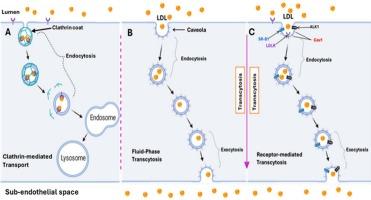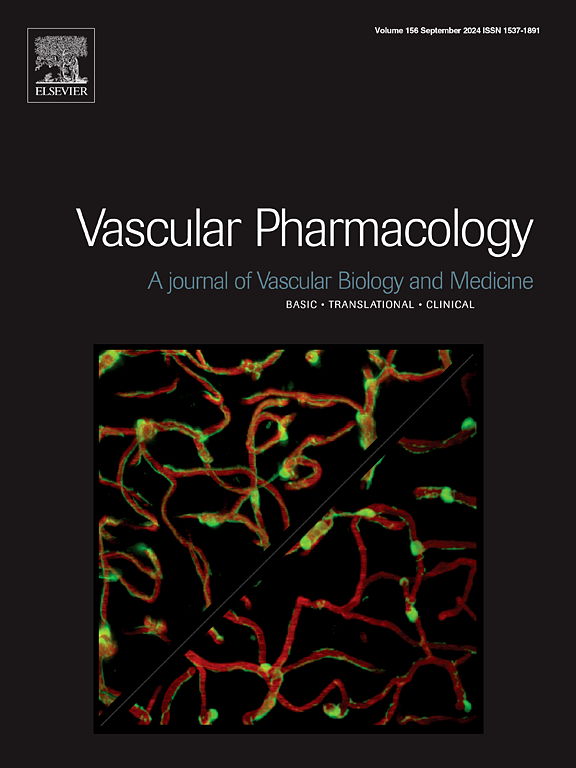动脉内皮对血浆LDL的跨细胞渗透性,是治疗动脉粥样硬化的一个未被充分探索的靶点:新的见解和潜在的治疗策略
IF 3.5
3区 医学
Q2 PHARMACOLOGY & PHARMACY
引用次数: 0
摘要
缺血性心脏病,其中动脉粥样硬化是主要底物,仍然是全球死亡的主要原因。动脉粥样硬化的特征是胆固醇的积累,主要来自动脉壁内循环的低密度脂蛋白(LDL)。LDL内流是由两个变量的乘积决定的:血浆中LDL的浓度和内皮对LDL的渗透性。降低前者是目前采用的主要治疗策略。同时,降低通透性应该同样有益,其对内流的影响可能与降脂作用倍增,但目前尚未充分探索其作为治疗动脉粥样硬化的靶点。电子显微镜技术的进步有助于提高我们对低密度脂蛋白渗透内皮的三种主要途径的理解:跨细胞(通过被动和主动,受体介导的运输,包括LDL作为货物在小泡内的运动),细胞旁(通过内皮间/细胞旁连接),以及通过细胞进行有丝分裂和凋亡(漏接)。因此,基于实验和转化研究的最新进展,我们在这篇综述中强调了调节经内皮细胞对LDL的渗透性的可行药物作为动脉粥样硬化的潜在治疗选择。本文章由计算机程序翻译,如有差异,请以英文原文为准。

Transcellular permeability of arterial endothelium to plasma LDL, an underexplored target in treating atherosclerosis: Novel insights and potential treatment strategies
Ischaemic heart disease, of which atherosclerosis is the primary substrate, continues to be a leading cause of death globally. Atherosclerosis is characterised by the accumulation of cholesterol, mainly from circulating low-density lipoprotein (LDL), within the arterial wall. LDL influx is determined by the product of two variables: the concentration of LDL in plasma and the permeability of the endothelium to LDL. Lowering the former is the primary therapeutic strategy employed today. Meanwhile, lowering permeability ought to be equally beneficial, and its effect on influx would likely be multiplicative with lipid lowering, but it is currently underexplored as a target in treating atherosclerosis. Advances in electron microscopy have helped improve our understanding of the three primary routes through which LDL permeates the endothelium: transcellular (via passive and active, receptor-mediated transport that involves the movement of LDL as cargo inside caveolae), paracellular (via interendothelial/paracellular junctions), and through cells undergoing mitosis and apoptosis (leaky junctions). We have therefore highlighted in this review, based on recent advances in experimental and translational investigations viable pharmacological agents that modulate transendothelial permeability to LDL as potential treatment options for atherosclerosis.
求助全文
通过发布文献求助,成功后即可免费获取论文全文。
去求助
来源期刊

Vascular pharmacology
医学-药学
CiteScore
6.60
自引率
2.50%
发文量
153
审稿时长
31 days
期刊介绍:
Vascular Pharmacology publishes papers, which contains results of all aspects of biology and pharmacology of the vascular system.
Papers are encouraged in basic, translational and clinical aspects of Vascular Biology and Pharmacology, utilizing approaches ranging from molecular biology to integrative physiology. All papers are in English.
The Journal publishes review articles which include vascular aspects of thrombosis, inflammation, cell signalling, atherosclerosis, and lipid metabolism.
 求助内容:
求助内容: 应助结果提醒方式:
应助结果提醒方式:


